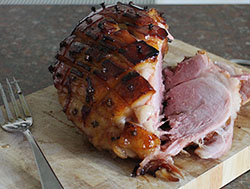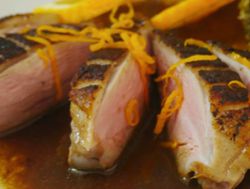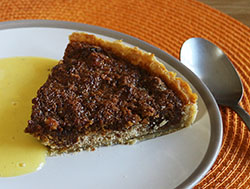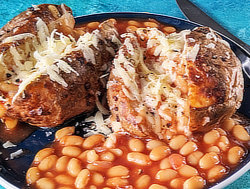
Roast Duck with Chestnut Stuffing
Introduction & method
A roast duck is a splendid thing any time of year, but at Christmas it makes a welcome change from turkey. The chestnut stuffing wrapped in a bacon is fabulous too.
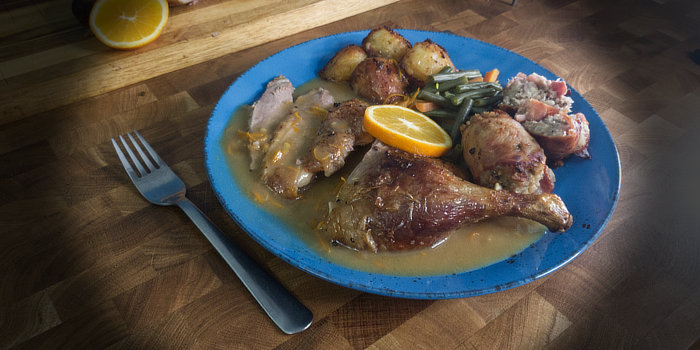
Make the Stuffing
If you can get ready-prepared chestnuts I would stongly recommend you do that. But if you do need to peel them, score a cross in the flat side and simmer them for 15 minutes. Remove the peel and the inner fluffy layer while the nuts are still hot - so don't take them all out of the water at once. Finely chop the chestnuts.
Top, tail, peel and dice the onion and gently sauté it in a small frying pan until it is soft and transparent but not browned - about 5 minutes. Allow to cool.
You can buy ready-made sausage meat, or you can get your favourite sausages and remove the meat from them. But if you want more control over what goes into it, mix 150 grams (5¼ ounces) of minced pork with 100 grams (3½ ounces) of breadcrumbs, salt, pepper, sage and a little splash of water.
When the onions are cool, mix them in with the sausagemeat, chestnuts and melted butter.
Make the Stuffing Rolls
For your bacon, you can use back or streaky, smoked or unsmoked. Take a handful of stuffing mix, compress it into a ball then flatten it into a sausage and roll a slice of bacon around it. Keep the rolls in the fridge until you are ready for them.
Prep the Duck
Your duck may come with giblets (internal organs) - these might be in a plastic bag in the body cavity. You need to remove this and you can use them to make stock with. Trim off any fatty flaps of skin around the body and neck cavity, and the tips of the wings - put these in with the stock as well. Ducks are notorious for the amount of fat that lurks just beneath their skin. You need this to melt (render) and run out during cooking, so pierce the skin all over with a cocktail stick. Some people also like to score the skin on the breast in a criss-cross pattern. Be careful when scoring to only cut through the skin, not the flesh. Rub in coarse salt and black pepper. Cut an orange in half and place the halves in the body cavity. Place the duck on a wire rack over a roasting tin - this stops the duck from sitting in its own fat and enables the fat to lubricate roast potatoes and maybe parsnips if you are doing those.
Make Duck Stock
You'll be making orange sauce later on and it will be really great if you have some duck stock to make it with - but don't worry if you haven't, chicken stock is pretty good too. Now, obviously you can't make this stock from the duck bones because they're still inside the duck. But the giblets and other trimmings make a good stock. You can do this in advance of cooking the duck because it will take on hour or two on the stovetop. You can reduce that time to 30 minutes if you use a pressure cooker. Add the giblets and trimmings to the pot along with coarsely chopped onion carrot and celery. Top up with enough water to cover everything, add the seasonings and herbs, bring up to pressure and cook for 20 minutes. Release the pressure, strain the liquid from the veggies and boil rapidly until reduced by half. Allow to cool somewhat then strain through a muslin cloth. Check for seasoning and set aside. You'll find that if you let it cool completely and chill it, a layer of fat will solidify on the surface - you might want to skim this off. But if you don't have time to do that the stock will be fine in the sauce.
Cook the Duck
Heat your oven to 180°C (356°F) for a fan/convection oven, 200°C (392°F) conventional, gas 6. A supermarket packaged duck will probably have cooking instructions and times on the packaging. The time given is likely to be quite a bit too long, so treat it as a guide, not an instruction. Generally, you should cook the duck for 20 minutes per 450 grams (1 pound). Baste it frequently during cooking. My duck was 2 kilos (5 pounds) trimmed weight so I calculated 90 minutes to cook it. But I checked its internal temperature about 15 minutes before the end of that time and it was done - it had reached the recommended temperature of 74° C (165°F). 40 minutes before the end of cooking time place your stuffing rolls in the tray under the duck.
When the duck is cooked remove it to a warmed plate and tent it in foil to rest for at least 20 minutes.
Make Orange Sauce
Melt the butter in a small saucepan. Add the star anise and let it cook for a minute or two. Add the flour and mix into a thick paste. Cook for two minutes, then add the stock, orange juice and zest, marmalade and vinegar. Stir well and cook until the sauce has thickened somewhat. Check for seasoning, add salt if necessary. Adjust the balance of marmalade and vinegar - it should be more acidic than sweet.
The video above is from the Keef Cooks YouTube channel. Click here to see the video recipe of Roast Duck with Chestnut Stuffing on YouTube.
Related recipes from Keef Cooks
You might also like these recipes:
Ingredients & Info
STUFFING
 250 grams sausage meat
250 grams sausage meat 200 grams
chestnuts
200 grams
chestnuts 1
medium onion
1
medium onion 6 rashers
bacon
6 rashers
bacon 1 tsp
dried sage
1 tsp
dried sage 30 grams
butter
30 grams
butterTHE DUCK
 1 fresh or frozen duck
1 fresh or frozen duck 1
orange
1
orange salt and pepper to taste
salt and pepper to tasteSTOCK
 giblets &/or duck bones and carcass
giblets &/or duck bones and carcass 1
medium onion
1
medium onion 1
medium carrot
1
medium carrot 1 stick
celery
1 stick
celery 1 tsp
salt
1 tsp
salt 1 tsp
black peppercorns
1 tsp
black peppercorns 2
bay leaves
2
bay leaves 1 tbsp
dried parsley
1 tbsp
dried parsleyORANGE SAUCE
 1
orange, juice and zest of
1
orange, juice and zest of 250 ml
duck or chicken stock
250 ml
duck or chicken stock 2 tbsp
balsamic vinegar
2 tbsp
balsamic vinegar 2 tbsp
marmalade
2 tbsp
marmalade salt and pepper to taste
salt and pepper to taste 1
star anise
1
star anise 30 grams
butter
30 grams
butter 30 grams
flour
30 grams
flour
Serves 4 -6
Prep time: 30 minutes.
20 minutes time: Resting.
Cooking time: 1 hour 50 minutes.
Total time: 2 hours 40 minutes.
Prep time: 30 minutes.
20 minutes time: Resting.
Cooking time: 1 hour 50 minutes.
Total time: 2 hours 40 minutes.

